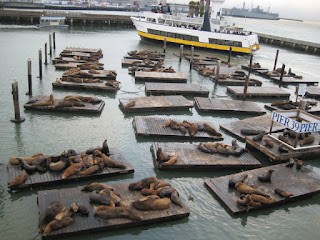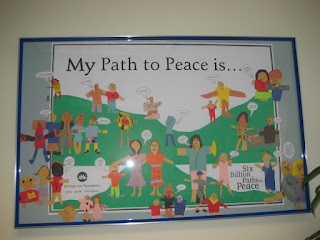
I arrived at the Marconi Center not having the slightest clue what to expect.
I also didn’t know that just over forty-eight hours, particularly a one-hour block of time spent merely staring and a timeless and seemingly endless experience that others have assured me was no longer than forty-five minutes, could completely change my outlook on life.
Within five minutes of being at the Marconi Center, five minutes of breathing the pine-filled air, five minutes of examining the bell-like poppies, five minutes of gazing at the ocean, all of the stress that not only constantly surrounds me but follows—no, chases, pursues me wherever I go, simply melted away, surrounding my feet but not being able to touch me. I had always known that school was not, contrary to popular belief, the purpose of our lives (and that one’s education is actually hindered by trying too hard to excel at it), but I had never been able to truly feel it until that first breath of pine-air.
The first thing we all did after marveling at our heavenly living quarters for longer than expected was explore the place, since we were several hours early to the retreat and honestly had nothing better to do (actually, I can’t think of anything I would rather have been doing at the time) only to discover the reason our bedrooms were so heavenly: we were, in fact, in some lower level, some earthly level, of Heaven. I would be glad to go further into the beauty of this place if you happen to have the floor-plan for Heaven with you right now. Otherwise it would take too long, and since my name isn’t John Steinbeck I won’t pester you with the details.
Along our journey two things stuck out as particularly incredible to me. The first was a miniature multi-tiered waterfall reminiscent of a Japanese garden in all its divinity. The other was a redwood tree. I never could find that tree again, although it did change the life of at least one other person at the retreat.
Later on that night when the other sixty-some-odd people arrived, we were split into nine “Home Groups”, each consisting of retreat-goers between the ages of fifteen and eighty-five. None of us will ever know how, but the “random” assignment of people to their respective Home Groups somehow managed to give each person at the retreat the perfect group of people to help them evolve spiritually.
I awoke unnaturally early the next morning and decided to walk around the Marconi Center on my own. Noticing only the plants, rocks, chipmunks and jackrabbit, but most certainly not where I was actually going, I found myself back at the waterfall. I decided to sit down on a rock on its bank and, as I so often do when I really don’t know what else to do, I just stared. I stared at the water. I am not confident in my ability to describe things without drawing them so bear with me: the top of the waterfall is of course just a clear pool. After the first fall the water is allowed to flow freely for a short ways, but is soon interrupted by small boulders that block part of its path. It is then free to flow a short distance until it falls down another waterfall. This continues for several tiers, the layers of rock becoming increasingly denser, making it more difficult for the water to pass through, but somehow it always does. But right before the last fall, there are no rocks. Instead there is a sheet of tall grass, like small stalks of bamboo. Certainly no insect or hummingbird that was on the water was able to see over the grass without flying above it. And over that last fall is a large, open, clear pool, where the water may flow as it pleases. And as I stared at the water I noticed bubbles forming at the top of the first fall, and I noticed that some of the bubbles flowed down the first waterfall, while some went the other way, and simply disappeared with a small pop. And I noticed that most, but not all, of the bubbles that made it down the first waterfall made it past the first set of rocks to the next waterfall, and most of the ones that fell down it continued to the next, until only a few of the original bubbles made it past the reeds to that final pool; and as I noticed these things I realized that this was all a metaphor for life: we are but bubbles in a fountain, and in order to make it to that final pool at the end, we must all find a way around the rocks and falls that block us, until we finally reach, at the end of each lifetime, the curtain of reeds, and the uncertainty of what lies beyond, and we must not be afraid of it, but instead we must—
I had just missed an incredible (or so I’m told) banana pancake breakfast.
As wonderful as the rest of that day was, I wish only to bring up an unknown quantity of time (though I know it was more than twenty minutes and less than three hours) spent sitting on a rock in between two forest paths where I had followed a chipmunk and two jackrabbits. My original intent for sitting on the rock was to observe the behavior of the two wild jackrabbits, for I often think of myself as a scientist and naturally am curious about many things, especially since the behavior of jackrabbits is not something easily observable in the heart of Oklahoma City. Eventually the jackrabbits left, and I was left grass and twigs on the ground, the rock I was contentedly sitting on, and two young trees to the left of the rock. I was bored, so I picked up a twig and tossed it between the trees. A recently-finished spider-web caught the twig in midair, and I watched as my inner child gaped in absolute wonder at the twig that could make itself fly. I tossed more twigs next to it, and there they were, standing in midair parallel to the trunks of the trees as the child marveled at what magic could possibly be at work here. And suddenly my heart became a metronome, and everything began to harmonize with it, though I could hear no sound but the occasional conversation between far-away sparrows. This is what I will define forever as “inner peace”.
The eighty or so people at the Retreat were to go through the Labyrinth in two waves, and I was in the second wave. I decided I’d go into the room with the Labyrinth while the first wave was going through just to see what exactly was going on. I’d had a crazy obsession with hot tea the whole weekend, so it came as no surprise to me that when I walked into the circular room containing the Labyrinth, the first thing I thought was that the room looked oddly like the cup or orange spice tea I was drinking at the time. Then I noticed the people. The people in the room were either sitting calmly, not saying anything and maybe drinking a cup of hot tea, or they were on the Labyrinth, walking or dancing along, completely unaware of their surroundings, each engaged in their own form of meditative movement. Outside of this room, any of these people would have been labeled a freak or an outcast by any other “normal” person, but not inside of it. Inside everyone’s inner mind seemed to surface and take over, and the body of each person was no longer under their conscious control.
And all I could do was watch and wonder what exactly this thing on the floor in front of me was that was causing these people to act like this.
The last person in the first wave left the room, and the spaces on the walls had filled with an entirely new group of people, the second wave of meditators.
“Welcome to the Labyrinth. Going through the Labyrinth is a form of meditation known to provide answers to those who seek answers, questions to those who seek answers, and answers to those who seek questions.” All three applied to me. “When I tap you on the shoulder, you may proceed into the Labyrinth. All I ask is that you stay within the path and not run into others. Now….we begin.”
After finishing the remains of my tea I entered the Labyrinth. The music playing sounded like the orange spice tea tasted, if that makes any sense. As I walked, I wondered what I was even doing there. After some unknown amount of time (it could have been a few seconds or an hour as far as I was concerned), my mind began to wander into a complex stream of something deeper than thought, or perhaps it just felt that way. I was suddenly aware of nothing but the inner workings of my mind, yet at the same time completely aware of everything in the room, the floor, the music, the people, and I was completely aware of the fact that we were all dancing like the steam on top of a hot cup of tea, not in unison but still somehow together, connected somehow by the environment the room created for us, connected, even though we were all perfect strangers.
The rest has been omitted for personal reasons.






























